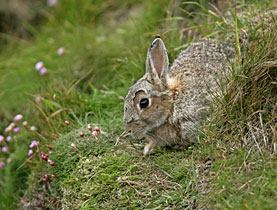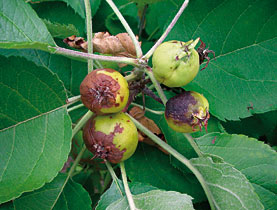Foreign invaders threaten native Swiss species

From mountain meadows to riverbanks, scientists say a silent war between foreign species and native Swiss plants and animals is unfolding all around us.
A project at Bern University has allowed scientists for the first time to take a sweeping look at the types of plants and animals that have moved to Europe from far-flung places.
Such an inventory, which relied on more than a hundred scientists and three years of collecting data, has never been done before on a continental level. Some of the findings are presented in a book published this week.
“The results are frightening,” Wolfgang Nentwig, a professor at the Institute for Ecology and Evolution at Bern University, told swissinfo.
The report, called Delivering Alien Invasive Species Inventory for Europe (Daisie), found there are now more than 11,000 types of non-native plants and animals living in Europe. Many of them could have a significant impact on the environment and health.
“New species aren’t an enrichment, they’re a danger,” Nentwig said.
“Invasive species become more frequent and because space and resources are limited, someone else has to disappear. Why is this a pity? Because native species are best adapted to our environment. When invasive species take over it leads to a McDonaldsisation, where everything is the same.”
Spiders
The effects can already be felt in the spider world. Nentwig said a research assistant recently collected 50 spiders near the institute in the Swiss capital, but 45 of the spiders were the same – a small North American arachnid with grey markings called a dwarf spider.
“Fifteen years ago that spider didn’t exist here,” he said, adding the spiders reached Europe through United States military traffic into Germany, where they have since spread into France and Switzerland.
“Since we started looking for it, we realised it is so common now, and the native spiders, well, we don’t know. Perhaps they’re gone.”
In the plant realm, Switzerland has a growing issue with giant hogweed, or cow parsley, a perennial from the Caucasus region with a dark reddish-purple stalk and spotted leaves, favoured by botanists and beekeepers.
Since being introduced about 25 years ago, the plant has taken over riverbanks and roadsides all across Switzerland, crowding out native plants. The dangers extend beyond biodiversity though.
“If you get it on your skin and then are exposed to UV light, like from the sun, your skin will burn and blister,” Nentwig said. “I mean burn. Not like a sunburn.”
Bugs and business
How Switzerland is faring is a bit difficult as the area is drastically understudied, Nentwig said. But it appears to be doing better that many other European countries thanks, in part, to its landlocked geography.
The Daisie Project found Switzerland has a total of 849 non-native species living within its borders, about the same as Portugal and Latvia.
Globalisation and increased trade between countries is one of the most effective vectors for introducing new species into ecosystems. For that reason, large, industrial countries or those with bustling ports are particularly infested.
Britain tops the list with more than 3,000 introduced species while Belgium has more than 2,500. Eastern European countries typically have far fewer invasive species, he said.
“For a long time the movement was from out of Europe to North America, Australia, and New Zealand and South Africa,” Nentwig said. But for years Europeans have grossly underestimated just how many non-native species live in Europe.
“Because we lacked reliable data, many European countries remained passive in the fight against non-native species,” he said. “Now we can all see the problem is clearly here.”
Nentwig said stricter quarantines for incoming goods needed to be put into effect to make sure goods are free of insects, seeds and fungus.
“More than 11,000 species isn’t a small number,” he said. “We don’t know the effects of 85 per cent of them. But even if 1,000 impact us, that’s a lot.”
swissinfo, Tim Neville
Top 10 European countries with the most invasive species:
Britain 3,060
Belgium 2,563
France 2,293
Czech Republic 1,951
Germany 1,810
Sweden 1,624
Italy 1,605
Denmark 1,495
Spain 1,467
Austria 1,462
Terrestrial plants make up the most common type of alien invader, with 6,634 species detected across Europe. Land-based invertebrates follow a distant second, with 2,536 species.
Most non-native plants and terrestrial invertebrates were introduced by people seeking plants for ornamental purposes.
Scientists are unable to pinpoint how many invasive vertebrates arrived in Europe, but hunting (181 species) and animals escaping from zoos (82) account for the two largest, known pathways.
The Delivering Alien Invasive Species in Europe project was funded by the European Commission to provide a “one-stop shop” for non-native species in Europe.
The group of scientists from all across Europe and the Mediterranean divided up into teams to provide data on species invading land, freshwater and marine environments. Together they assembled information on species from a total of 63 regions, countries and islands all across the continent.
The project aims to provide European scientists and public officials with tools to develop a Europe-wide plan toward reducing invasive species.

In compliance with the JTI standards
More: SWI swissinfo.ch certified by the Journalism Trust Initiative











You can find an overview of ongoing debates with our journalists here . Please join us!
If you want to start a conversation about a topic raised in this article or want to report factual errors, email us at english@swissinfo.ch.